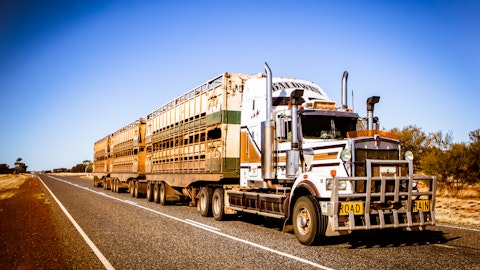ArcBest Corporation (NASDAQ:ARCB) Q3 2023 Earnings Call Transcript October 27, 2023
ArcBest Corporation misses on earnings expectations. Reported EPS is $1.42 EPS, expectations were $1.55.
Operator: Greetings, and welcome to the ArcBest Third Quarter 2023 Earnings Conference Call. During the presentation, all participants will be in a listen-only mode. Afterwards, we will conduct a question-and-answer session. [Operator Instructions] As a reminder, this conference is being recorded Friday, October 27, 2023. I would now like to turn the conference over to Mr. David Humphrey, Vice President of Investor Relations. Please go ahead.
David Humphrey: Thank you for joining us. Today, we’ll provide an update on our business, walk you through the details of our third quarter 2023 results, and then answer some questions. Joining me today for the prepared remarks are Judy McReynolds, Chairman, President and CEO, ArcBest; Matt Beasley, Chief Financial Officer and Treasurer; Seth Runser, President of ABF Freight; and Steven Leonard, Chief Commercial Officer and President of Asset-light Logistics. In addition Dennis Anderson, Chief Strategy Officer; and Christopher Adkins, Vice President of Yield Strategy & Management are available to answer questions. To help you better understand our best and our results, some forward-looking statements could be made. Forward-looking statements, by their very nature are subject to uncertainties and risk.

A tractor-trailer speeding along a modern highway, showing the power of the transportation solutions.
For more complete discussion of factors that can affect our best future results. Please refer to the forward-looking statements section of our earnings press release and our most recent SEC public filings. To provide meaningful comparisons certain information discussed in this call includes non-GAAP financial measures as outlined and described in the tables in our earnings press release. Reconciliations of the GAAP financial measures to the related non-GAAP measures discussed in this call are also provided in the Additional Information section of the presentation slides. There is also a conference called slide deck that can be found on the ArcBest website arcb.com in exhibit 99.3, of the 8-K that was filed earlier this morning. Now, I will turn the call over to Judy for some opening comments.
Judy McReynolds: Thank you, David, and good morning. Thank you for joining us. We’ve been celebrating ArcBest’s 100th anniversary this year, an extraordinary milestone, which is a testament to the ArcBest team and the strength of our customer focused strategy. We work every day to be trusted advisors to our customers, which includes some of the world’s largest and most recognizable brands. With ArcBest’s full suite of shipping and logistics solutions, our work is critical to our customers’ businesses and we don’t take that lightly. We constantly work to see the world through their eyes and look ahead to help them anticipate and respond to market changes and disruptions. In fact, we view our close, collaborative and highly strategic customer relationships as an important competitive differentiator.
While the overall logistics market remained soft in the third quarter, we benefited from our ability to help customers navigate market disruption. In this time of increased uncertainty, I saw the strength of our strategy firsthand as we provided integrated solutions, which our customers relied on, to ensure their goods continued moving through the global supply chain. We reacted with agility and I’m encouraged by the conversations we’ve had with customers. They reiterated that our flexible capacity and logistics expertise has met and exceeded their needs. We significantly improved our published shipment levels and pricing in our Asset-Based business on a sequential basis and our managed transportation solution in our Asset-Light business saw shipment count levels reach an all time high.
Our relationships with our customers and commitment to innovation have been key drivers in our revenue more than tripling and profitability significantly improving over the last decade, and we’re not done. We continue to invest in facilities, technology and innovation, and our team. These key areas will accelerate growth and unlock additional value moving forward. First, we have a strong footprint of facilities today, which allows us to service our customers efficiently. We continue to invest in further expansion and see the opportunity to accelerate our facility plan in the current LTL real estate environment. Second, our deep commitment to technology and innovation has enabled us to transform our company and we continue to pursue a robust set of initiatives.
For example, earlier this year, we deployed a generative AI tool to support an internal team that performs quality audits of our customer service interactions. This team removes friction points and improves hundreds of processes every year and this new tool quickly provides key insights to further advance these efforts. In addition, our ABS city route optimization project has leveraged AI to reduce mileage and decrease fuel consumption, which supports a more sustainable future. Looking ahead, we will continue developing and investing in solutions to support best-in-class service to our customers and drive business efficiencies. Lastly, our values driven culture is deeply rooted in creativity, integrity, collaboration, growth, excellence and wellness.
We are committed to investing in our people and living out our core values every day. Before I hand the call over to Matt, I’d like to offer a few observations about what we’re seeing in each of our business segments. In our Asset-Based segment, the current LTL market dynamics are contributing to improved trends. Our team continues to respond nimbly to evolving market dynamics in real time, pivoting quickly to fill our network in the most profitable way. In our Asset-Light business, while we are growing customers and shipment volumes, we are not immune to market conditions and continue to work to find efficiencies. We have managed down costs and our team has done a great job of growing our customer base and shipment count. Our ability to help customers navigate market disruption over the past few months has demonstrated the strength of our highly experienced team and our broad suite of integrated logistics solutions.
We were there for our customers to help them think holistically about their supply chains, while providing a service offering not available from pure play operators. And we continue to see opportunities to expand our relationships with existing customers. And now, I will turn it over to Matt to take you through the quarter in greater detail.
Matt Beasley: Thank you, Judy, and good morning, everyone. I will provide an overview of the quarter and give an update on our balance sheet and capital deployment plans. Consolidated revenue from continuing operations was $1.1 billion for the quarter down 9% year-over-year. On an non-GAAP basis, consolidated operating income was $75 million, down 43% and adjusted third quarter earnings per diluted share was $2.31. While our consolidated results reflect a softer overall market than last year, we have benefited by having the right capacity options and expertise to serve customers during this period of market disruption and have also seen results from our cost savings and efficiency initiatives. In the Asset-Based business, revenue was $741 million, down 4% year-over-year on a daily basis, and non-GAAP operating income was $83 million.
Overall, pricing remains rational, and has been strengthened by recent market events. For asset-based customer contract renewals and deferred pricing agreements negotiated during the third quarter, we secured a 4% average increase. The benefit of our costs and efficiency efforts in this segment included a reduction in purchased transportation, cartage and equipment rental costs. The third quarter non-GAAP asset-based operating ratio of 88.8% reflects a sequential improvement of 400 basis points compared to second quarter, which is particularly noteworthy because our new labor agreement added approximately 350 basis points of costs relative to second quarter. Excluding that increase, our sequential operating ratio improvement was approximately 750 basis points.
That impressive result did not happened by accident, and I am proud of the way our team came together over the last few months to serve our customers during the time of market disruption, while remaining focused on cost and efficiency. I am also pleased to report that, we have carried this momentum into the fourth quarter. Excluding periods impacted by the pandemic, the average sequential change in ArcBest asset-based operating ratio from the third quarter to fourth quarter during the prior 10 years has been an increase of 100 to 300 basis points. Despite this historical trend, after considering the impacts of the market disruption, recent commercial successes, a general rate increase and cost reduction efforts, the asset-based operating ratio is expected to modestly decrease from third quarter 2023 to fourth quarter 2023.
Transitioning to Asset-Light, third quarter daily revenue decreased 17% year-over-year. This was primarily due to lower revenue per shipment. The segment had a non-GAAP operating loss for the quarter of $4 million. We provided preliminary Asset-Light business trends for October 2023 in the Form 8-K exhibit to the press release filed this morning. And operating statistics in that business continue to reflect a softer market compared to last year. Net capital expenditures totaled for $155 million for the first nine months of the year, and we currently expect net capital expenditures in the range of $270 million to $285 million for the full year, which is slightly lower than our previous estimate last quarter. Our Class 8 tractor orders remain in place and we currently expect to receive all ordered road tractors by the end of the year.
ArcBest cash balance and total liquidity remained at strong levels. As of the end of the third quarter, we had a net cash balance of $98 million, an improvement of $36 million since the end of last year. Total liquidity stands at approximately $581 million, and despite rising rates, the composite interest rate on ArcBest’s outstanding debt at the end of the recent quarter was 3.3%. Our solid financial position and strong balance sheet position us well for the future. Our capital allocation strategy includes organic capital investment and new equipment purchases, real estate additions and upgrades, and technology investments, which will enable us to continue serving our customers with excellence now and into the future. We are monitoring the market for external growth opportunities to enhance our business and we are returning capital to shareholders, while targeting investment grade credit metrics.
So far this year through yesterday, our settled share repurchases and dividends paid have returned approximately $86 million of capital to shareholders. Based on those share repurchases, approximately $48 million remains available under the current repurchase authorization for future common stock purchases. In conclusion, I’m excited about our future. We are helping guide our customers through the current market with a century of experience under our belt. Our proven ability to excel across different cycles is a testament to our resilience and our strategy and our robust balance sheet stands out, especially when customers are in search of stability in uncertain times. Now, I’ll turn the call over to Seth to discuss our Asset-Based business.
Seth Runser: Good morning. I am pleased to report ABF grew daily shipments during the quarter over 1% year-over-year, while aggressively managing costs and focusing on efficiency without limiting growth. With a large amount of capacity leaving the market, customers came to us to keep their freight moving. This helped in achieving a more optimal mix of freight in our network, which improved profitability. In short, we’ve been able to reduce costs while improving service. As Matt said, we have reduced costs in purchased transportation, cartage and rental equipment, and we continue to enhance dashboards for our leaders, which provide real time visibility to business and productivity levels. This enables our team to quickly and effectively take action to ensure we are using our resources in the most effective manner.
As we enter our 101st year, we continue to transform ABF through innovation, investment and an intense focus on quality. For the past two years, we’ve been working to improve some foundational systems and processes. We’ve completed over a dozen initiatives to improve our operation and we have many more in progress. You can see the results of these efforts and the sequential improvement in our operating ratio but our continuous improvement journey is ongoing. We are a high quality carrier and that means our product must be high quality. I’m pleased with our progress, but we still have more work to do. In closing, I want to highlight our approach to managing our ship levels and optimizing our network. Our long history of using data to make decisions and the sheer amount of data we have enables us to optimize our business daily.
And our levers of using dynamic pricing in UPAC to fill empty capacity are key strategic differentiators. I’m grateful for the collaboration between our teams in the third quarter, where we quickly adapted to the market to increase our mix of core business. Through our facility investments, we have added over 200 doors this year and plan to add more than 500 additional between now and the first quarter of 2025. Our focus remains on service, efficiency, and profitable growth and we’re not slowing down. Now, I’ll turn the call over to Steven.
Steven Leonard: Thanks, Seth, and good morning, everyone. In the Asset-Light business, truckload margins remained soft, but we grew shipments despite weak demand and even achieved record shipment levels for our managed transportation business as we help customers navigate market disruption, which is a testament to the strength of our solutions and deep customer relationships. As Matt mentioned, we’ve been aggressively managing cost we continue to look for ways to further align costs with business levels and improve efficiency. While market disruptions continue, our breadth of integrated solutions positions us well to serve customers. Our managed transportation within our using our managed transportation solution, we were able to help shippers who were impacted by the reduction in LTL capacity.
We partnered with them to understand their supply chain needs and helped them avoid the capacity constraints others may have experienced. We offered creative solutions using multiple modes to keep our customers’ supply chains moving, resulting in a better outcome for our customer. And as customers have seen significant disruptions in the market, our stability and financial strength are differentiators. Customers need a partner they can count on, and we are well positioned to meet their needs. Now back to Judy for some final thoughts.
Judy McReynolds: Thank you, Steven. Our success has been deeply tied to the ongoing pursuit of our mission to connect and positively impact the world through solving logistics challenges. We live this mission to the fullest this quarter as we navigated and successfully responded to industry disruptions. We are well positioned to understand and address customer needs with powerful capabilities and the deep expertise of a trusted team. As we look to the future, we are confident that this strong position and a keen focus on our three strategic pillars of growth, efficiency and innovation will enable us to accelerate from here. This concludes our prepared remarks and we’ll now open the call up for questions.
David Humphrey: Okay, Frank. I think we’re ready for some questions.
Operator: [Operator Instructions] Our first question comes from Ravi Shankar with Morgan Stanley. Please proceed.
Ravi Shankar: So when everybody in the space is looking at the volume and revenue opportunities, you guys crushed it on costs, which was truly remarkable to see. Can you just unpack that a little bit more? Was this just operating leverage from getting more density with more volumes coming into the network? Were these explicit cost actions that were in the pipeline for a while, are there more to come? I think the number one question in people’s mind this morning is kind of how sustainable is this? So, I would love to get go there, please.
See also 15 Best Laptops in 2023 For Students or Home Use and Richest Cities in Every State in the US.
Q&A Session
Follow Arcbest Corp (NASDAQ:ARCB)
Follow Arcbest Corp (NASDAQ:ARCB)
Judy McReynolds: Yes, thanks for the question, Ravi, and it’s a good one. We saw the opportunity to better address our costs as we were adding people over the years of 2022 and 2021 and making sure, that we had them to proficient productivity levels and a good experience and that sort of thing. And we’ve always in the past used variable costs such as purchase transportation, cartage and rent equipment to help facilitate our growth needs. But as we were finalizing our labor deal, looking at the proficiency level of our people and just the backdrop of the economy and the opportunity set, we saw a better answer, and really got focused on reducing some of those variable costs and making sure that we had the right business mix as we were going into the third quarter.
Ravi Shankar: Great. And so, is this consider it to be like a onetime reset or do you think there’s kind of more to come in the pipeline?
Judy McReynolds: Well, what I think is, we’re always adjusting and we’re wanting to make sure that we have the right resources serving the best business mix. And I think that the asset-based team does a great job of that along with working with our sales opportunities, and our yield managers. We really see this as a an ongoing effort to make sure that our resources that we are deploying are the most efficient and effective, while also just having a keen focus on serving our customers well.
Operator: Our next question comes from Jason Seidl with TD. Please proceed.
Jason Seidl: Thank you, operator, Judy and team, good morning, appreciate the time. Wanted to ask a quick question on some of the October trends. Did you guys see any benefit from the cyber attack at SDs? And then, if I look at cost real quickly, if you exclude labor, are you guys starting to see a little bit of a deterioration in sort of the inflationary cost environment?
Christopher Adkins: Hey, Jason, this is Christopher Atkins. I will kind of report on the cyber event as it relates to our business. We did see an influx of some of that business in the first couple of weeks of October. And largely that was from customers, existing customers of ABF that were able to help them during that time of disruption. Since then, that has largely gone back to the carrier that was handling that previously. But we are still even apart from that seeing substantial growth in our core business. As we have talked about, that business is still up 20% in October and compared to June of ’23.
Jason Seidl: Okay. Alright. That’s good color. And on the cost side?
Seth Runser: This is Seth. I would say on the cost side, we are starting to see some things normalize, but there is other areas like trailers for example where the cost is still inflated versus historical averages, but we are seeing some things start to normalize quite a bit on the cost side.
Judy McReynolds: Yes, I would, one, just recent conversation that I have been in. I think the insurance market they are pretty hardened right now. And so, we are working through the answer there. But that’s going to be one that we are watching just to highlight it.
Operator: Our next question comes from Ken Hoexter with BofA. Please proceed.
Ken Hoexter: So just two questions. Shipments were up 4% year-over-year in October. Thoughts on your capacity availability now? How much can you handle the growth you talked about adding 500 doors, but between now and ’25? And then I guess on the financial side, to Ravi’s question, what changed from targeting flat OR to up 400 basis points? I mean, you gave mid quarter updates. I am just wondering, on that cost side to the permanency question, he is asking, what changed from your point of view aside from — bankruptcy, which you knew by that point, just to see the sustainability of those costs. Thanks.
Matt Beasley: Good morning, Ken. This is Matt. So maybe I will start with your last part of your question then I will turn it over to Seth to cover the first part. Certainly, we saw continued momentum through the quarter. And so you could see that in how we talked about it. So when we were talking on the call in July, we were talking about being able to target a flat OR, even after the impacts of the new contract. Then we roll forward to the update that we provided in August. And that’s when we are really starting to see the impact of the cost and efficiency measures that we had put in place, certainly the market impacts are really starting to be felt. And so at that point in time, when we were saying that we thought we could not only, overcome those increased costs, but actually should be able to show some modest improvement in the OR and certainly that momentum just continue to carry into September.
And so that’s ultimately what resulted in the ability to be able to improve it by 400 basis points sequentially. And then, I’d say that kind of progression really spells out and plus in conjunction with the GRI that was put in early in October for us to continue that momentum into the fourth quarter, which is why we said that we think we can see potentially decrease sequentially into the fourth quarter as well. And then I’ll turn it over to Seth to cover the first part.
Seth Runser: Yes. So when I think about excess capacity in the market, it really comes down to four different things. The first is people and we feel pretty good that we’re properly staffed for our current business levels and we continue to replace attrition in strategic locations, we have a good line of sight on our growth pipeline and we feel like we can bring on labor much easier and quicker than we did throughout the pandemic, which is a good thing. So feel pretty good about people. On the equipment front, we continue to invest in the fleet like we have for many years. We have one of the newest fleets on the road. Our fleet slightly bigger and we’re working on getting some of those higher cost units out now, but we could pivot for growth, but I really don’t see any concerns on equipment capacity for growth.




